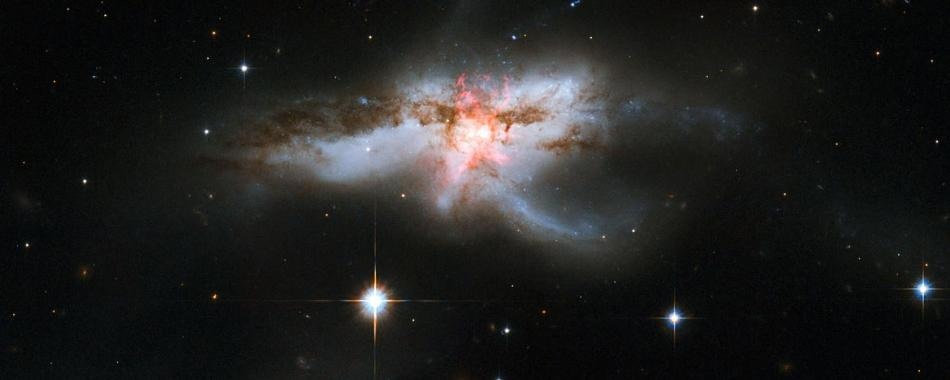Apr 20 2018
An extraordinary “dissection” of twin galaxies in the last stages of merging has been completed by CU Boulder researchers.
 NGC 6240 as seen by the Hubble Space Telescope. (Image credit: NASA, ESA, the Hubble Heritage (STScI/AURA)-ESA/Hubble Collaboration, and A. Evans (University of Virginia, Charlottesville/NRAO/Stony Brook University))
NGC 6240 as seen by the Hubble Space Telescope. (Image credit: NASA, ESA, the Hubble Heritage (STScI/AURA)-ESA/Hubble Collaboration, and A. Evans (University of Virginia, Charlottesville/NRAO/Stony Brook University))
The latest study, led by research associate Francisco Müller-Sánchez, searches a galaxy known as NGC 6240. While a majority of the galaxies in the universe contain only one supermassive black hole at their center, the NGC 6240 holds two - and they are circling each other in the final steps before crashing together.
The research discloses how gases expelled by those spiraling black holes, along with gases ejected by stars in the galaxy, may have started to power down the NGC 6240’s creation of new stars. Müller-Sánchez’s team also reveals how these “winds” have assisted in creating the NGC 6240’s most significant feature: an enormous cloud of gas in the shape of a butterfly.
“We dissected the butterfly,”
This is the first galaxy in which we can see both the wind from the two supermassive black holes and the outflow of low ionization gas from star formation at the same time.” said Müller-Sánchez of CU Boulder’s Department of Astrophysical and Planetary Sciences (APS).
Galaxies like NGC 6240—which play host to two well-fed supermassive black holes of a class known as Active Galactic Nuclei (AGNs)—are comparatively uncommon. They have garnered a lot of attention; however, as they provide a glimpse of a crucial stage in the evolution of galaxies like the Milky Way. Scientists are certain that such galaxies are formed by the union of two parent galaxies.
But the NGC 6240 is strange in other ways, Müller-Sánchez added. In contrast to the Milky Way, which forms a comparatively tidy disk, bubbles and jets of gas are expelled from the NGC 6240, spreading about 30,000 light years into space and looking like a butterfly in flight. Researchers suppose that this butterfly may be related to the galaxy’s twin hearts.
“Galaxies with a single AGN never show such a phenomenal structure,” he said.
To examine the idea, the CU researchers and their colleagues pooled observations from three different telescopes: the Hubble Space Telescope, the Very Large Telescope in Chile and Apache Point Observatory in New Mexico—which is owned by a consortium of universities including CU Boulder.
In a study published on April 19, 2018, in Nature, the team revealed that two different forces have given birth to the nebula. The butterfly’s northwest corner, for instance, is the product of stellar winds, or gases that stars release through different processes. The northeast corner, on the other hand, is controlled by a single cone of gas that was expelled by the pair of black holes—the result of those black holes gobbling up huge quantities of galactic dust and gas during their union.
“The data from these three telescopes allowed us to determine the location and velocity of different types of gas in the galaxy,” said Rebecca Nevin, a graduate student in APS and a co-author on the paper. “This helped us uncover two winds—one that is driven by dual supermassive black holes, and one that is driven by star formation.”
Those two winds combined expel about 100 times the mass of Earth’s sun in gases from the galaxy yearly, a “very large number, comparable to the rate at which the galaxy is creating stars in the nuclear region,” according to Müller-Sánchez.
Such a discharge can have huge consequences for the galaxy itself. When two galaxies unite, he said, they start an intense burst of new star formation. Stellar winds and black hole, however, can decelerate that process by dissipating the gases that make up fresh stars—similar to how a gust of wind can blow away a pile of leaves that was just raked. The team suspects that they are observing such “negative feedback” on star formation begin to amass in the NGC 6240.
“NGC 6240 is in a unique phase of its evolution,” said Julie Comerford, an assistant professor in APS and a co-author of the new research. “It is forming stars intensely now, so it needs the extra strong kick of two winds to slow down that star formation and evolve into a less active galaxy.”
The study’s other co-authors include Richard Davies at the Max Planck Institute for Extraterrestrial Physics in Germany, Ezequiel Treister at the Pontifical Catholic University of Chile and George Privon at the University of Florida.